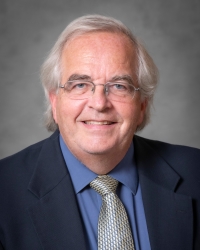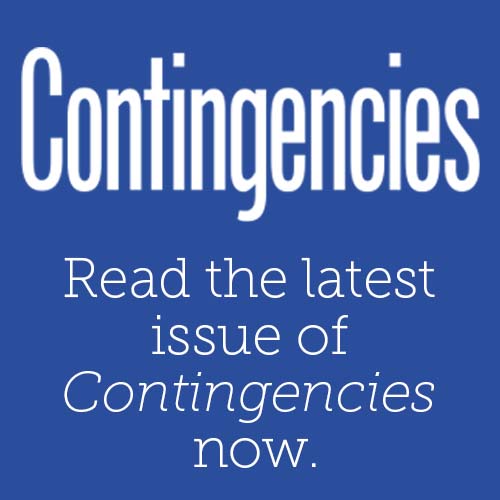Letter from the President
 The world is changing. Advancements in science and medicine are helping to keep disease at bay, extending healthy lives for millions of Americans. Technological progress continues to accelerate, altering and improving our existence in myriad ways both big and small. And financial institutions are becoming ever-more innovative, offering complex products tailored for every individual situation.
The world is changing. Advancements in science and medicine are helping to keep disease at bay, extending healthy lives for millions of Americans. Technological progress continues to accelerate, altering and improving our existence in myriad ways both big and small. And financial institutions are becoming ever-more innovative, offering complex products tailored for every individual situation.As the world shifts, the actuarial profession is evolving to meet these challenges. Health and pension actuaries are hard at work making sure their projections reflect the latest medical discoveries and improvements in mortality experience. Casualty actuaries are pondering how Big Data, cyber risk, and autonomous vehicles will affect their clients’ business. Life actuaries are rolling up their sleeves and rethinking how insurance companies need to set aside reserves in a world of principle-based reserving.
And through it all, the American Academy of Actuaries is the steady hand on the wheel, assuring the actuarial profession provides an objective, independent, and effective voice on financial security matters of national importance.
Over the years, the Academy has assembled a full toolkit of helpful items that support our mission—to serve the public and the United States actuarial profession—tools that effectively provide the structure for professionalism. The Academy and its component bodies have developed foundational documents such as the Code of Professional Conduct, the actuarial standards of practice, and the U.S. Qualification Standards (USQS). We have created tools such as the Applicability Guidelines for the standards of practice, FAQs and responses to individual questions for the Qualifications Standards, the USQS Attestation Form, and institutionalized requests for guidance (RFGs). Yes, we have the tools, but we also need to communicate about our profession effectively with our audiences.
An analogy that I used during my term as Academy president is that we need to turn our black boxes into glass boxes. We need to be totally clear and transparent in all we do. As the Dalai Lama once said: “A lack of transparency results in distrust and a deep sense of insecurity.” A corollary to that is that full transparency leads to trust and a sense of security—which is what we are all about.
And that brings us to the long-standing, tried-and-true exposure processes for the Actuarial Standards Board (ASB) and the Committee on Qualifications (COQ). The ASB, which is responsible for the development and promulgation of actuarial standards of practice (ASOPs) for actuaries in the United States, issues exposure drafts and solicits comments on all proposed ASOPs. After carefully considering each comment received and revising the draft accordingly, it’s common for second, third, or even occasionally fourth exposure drafts to be released before the ASOP is issued as final—the ASB wants to be certain that the standards it releases describe appropriate practice, taking into account all perspectives and serving both the profession and the public.
Similarly, the COQ is fastidiously transparent in its important work overseeing matters related to qualifications for U.S.-based actuaries. For the most recent revision to the USQS, which became effective January 1, 2008, the COQ received more than 200 comments on the final exposure draft. The COQ studiously weighed each of these comments before recommending the 2008 revision to the USQS to the board for adoption. That outcome expanded the reach of the USQS to many more actuaries beyond those only signing prescribed (statutory) statements of actuarial opinion. This expansion improved actuarial work, strengthened the profession, and enhanced actuaries’ reputation.
The professionalism bodies within the Academy—and indeed, every committee, subcommittee, work group, and task force of the Academy—can be relied on because of the objective, independent, and rigorously reviewed nature of the work they do. Especially during this period of rapid and uncertain change, the U.S. public and the actuarial profession can trust that the Academy works daily to serve them both. It is the robust, tested, and proven processes in place that make certain that trust is earned.
The 2017 Record describes the wide range of public policy activities coming out of the Academy’s various practice councils. These activities—letters to Congress, monographs, practice notes, issue briefs, and policy papers—represent the many different areas of actuarial practice, and they address some of the most critical policy issues facing the nation today. As you read about the varied activities of our practice councils, consider how the Academy’s efforts reach a variety of audiences, including Congress, federal regulators, state regulators and international audiences. I’m proud of the work we do and the extent of our reach, and I hope you are too.
On the international front, the Academy continued to serve as the voice of the U.S. actuarial profession on the global stage. In 2017, the International Actuarial Association (IAA) developed and continued to discuss a draft education syllabus and proposal to designate that syllabus as a minimum requirement for full member associations (FMAs). While the Academy has indicated its support for the IAA in the goal of assisting FMAs with developing models to improve their educational programs, we have consistently expressed concerns with any effort by the IAA to establish a universal mandatory educational curriculum for all its FMAs. To that end, I, along with Penultimate President Tom Wildsmith, outlined in multiple ways to the IAA a number of the Academy’s concerns and recommendations for proceeding with a syllabus, stressing that actuarial practice is jurisdiction-specific, reflecting local laws, regulations, business practices, markets, and the associations of the IAA are in no way regulated by that association of associations. These are all essential elements of self-determination that exist in the U.S. and it has been the Academy that assures the U.S. profession can continue to be what it must be—U.S.-centric.
The Academy maintained its role as providing the infrastructure for professionalism for U.S. actuaries. In 2017, after years of various voices in the profession advocating for identifying qualifications and standards for non-actuaries (“para-actuaries”) who provide essential support to actuaries everywhere, we made an in-depth independent examination of whether there was a mission-justified role for the Academy in professionalizing “para-actuaries.” Using expert outside consultants and an extensive survey and data collection process from employers of actuaries and individual actuaries themselves, we undertook a multi-year, multi-part analysis to understand what kind of program would be valued by employers, actuarial support personnel, and our members, and whether the Academy’s execution of such a program would create positive change and value for the profession. The Board found a moderate level of employer support for a continuing education program but not for a formal credentialing program; it also found a low level of support from credentialed actuaries for a potential program. As a result of this extensive analysis, the Board decided that establishing a paraactuary program was outside our core mission and would not add value to those we serve.
Membership in the Academy continued to grow to over 19,000, of which more than 1,200 volunteer their time and expertise. These volunteers represent the U.S. actuarial community’s shared commitment to professionalism and serving the public. The changing world needs our independent and objective input now more than ever, and I’m grateful for it.
I would also like to recognize the dedication and diligence of Academy staff. Their commitment to sustaining the U.S. actuarial profession—its professionalism infrastructure and public policy work—is another source of strength. We simply could not achieve our mission without their able support.
We live in exciting times—both as individuals and as a profession. I’m confident that the Academy stands ready to help steward the profession through this period of change, just as it has for more than 50 years.
(The Record, 2017)
Share







